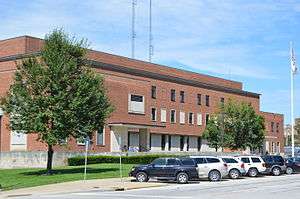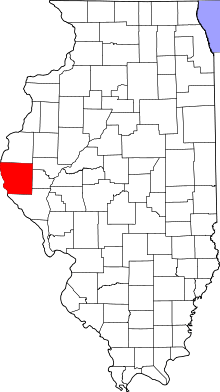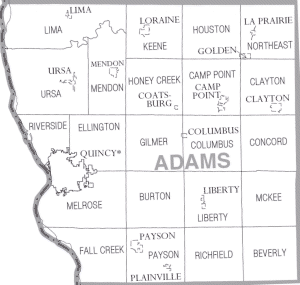Adams County, Illinois
Adams County is the westernmost county of the U.S. state of Illinois. As of the 2010 census, the population was 67,103.[2] Its county seat is Quincy.[3]
Adams County | |
|---|---|
 | |
 Location within the U.S. state of Illinois | |
 Illinois's location within the U.S. | |
| Coordinates: 39°59′N 91°11′W | |
| Country | |
| State | |
| Founded | 1825 |
| Named for | John Quincy Adams |
| Seat | Quincy |
| Largest city | Quincy |
| Area | |
| • Total | 871 sq mi (2,260 km2) |
| • Land | 855 sq mi (2,210 km2) |
| • Water | 16 sq mi (40 km2) 1.9% |
| Population (2010) | |
| • Total | 67,103 |
| • Estimate (2018)[1] | 65,691 |
| • Density | 77/sq mi (30/km2) |
| Time zone | UTC−6 (Central) |
| • Summer (DST) | UTC−5 (CDT) |
| Congressional district | 18th |
| Website | www |
Adams County is part of the Quincy, IL–MO Micropolitan Statistical Area.
History
Adams County was formed in 1825 out of Pike County. Its name is in honor of the sixth President of the United States, John Quincy Adams.
 When it was created, Hancock County was temporarily attached to Adams until it could organize a county government.[4]
When it was created, Hancock County was temporarily attached to Adams until it could organize a county government.[4] Adams County reduced to its current borders in 1829.
Adams County reduced to its current borders in 1829.
Geography
| Quincy, Illinois | ||||||||||||||||||||||||||||||||||||||||||||||||||||||||||||
|---|---|---|---|---|---|---|---|---|---|---|---|---|---|---|---|---|---|---|---|---|---|---|---|---|---|---|---|---|---|---|---|---|---|---|---|---|---|---|---|---|---|---|---|---|---|---|---|---|---|---|---|---|---|---|---|---|---|---|---|---|
| Climate chart (explanation) | ||||||||||||||||||||||||||||||||||||||||||||||||||||||||||||
| ||||||||||||||||||||||||||||||||||||||||||||||||||||||||||||
| ||||||||||||||||||||||||||||||||||||||||||||||||||||||||||||
According to the U.S. Census Bureau, the county has a total area of 871 square miles (2,260 km2), of which 855 square miles (2,210 km2) is land and 16 square miles (41 km2) (1.9%) is water.[6]
Adjacent counties
- Hancock County - north
- Brown County - east
- Schuyler County - east
- Pike County - south
- Marion County, Missouri - west
- Lewis County, Missouri - west
Major highways









National protected area
Climate and weather
In recent years, average temperatures in the county seat of Quincy have ranged from a low of 16 °F (−9 °C) in January to a high of 88 °F (31 °C) in July, although a record low of −21 °F (−29 °C) was recorded in January 1979 and a record high of 105 °F (41 °C) was recorded in July 2005. Average monthly precipitation ranged from 1.36 inches (35 mm) in January to 4.61 inches (117 mm) in May.[5]
Demographics

| Historical population | |||
|---|---|---|---|
| Census | Pop. | %± | |
| 1830 | 2,186 | — | |
| 1840 | 14,476 | 562.2% | |
| 1850 | 26,508 | 83.1% | |
| 1860 | 41,323 | 55.9% | |
| 1870 | 56,362 | 36.4% | |
| 1880 | 59,135 | 4.9% | |
| 1890 | 61,888 | 4.7% | |
| 1900 | 67,058 | 8.4% | |
| 1910 | 64,588 | −3.7% | |
| 1920 | 62,188 | −3.7% | |
| 1930 | 62,784 | 1.0% | |
| 1940 | 65,229 | 3.9% | |
| 1950 | 64,690 | −0.8% | |
| 1960 | 68,467 | 5.8% | |
| 1970 | 70,861 | 3.5% | |
| 1980 | 71,622 | 1.1% | |
| 1990 | 66,090 | −7.7% | |
| 2000 | 68,277 | 3.3% | |
| 2010 | 67,103 | −1.7% | |
| Est. 2018 | 65,691 | [1] | −2.1% |
| U.S. Decennial Census[7] 1790-1960[8] 1900-1990[9] 1990-2000[10] 2010-2013[2] | |||
As of the 2010 United States Census, there were 67,103 people, 27,375 households, and 17,677 families residing in the county.[11] The population density was 78.5 inhabitants per square mile (30.3/km2). There were 29,842 housing units at an average density of 34.9 per square mile (13.5/km2).[6] The racial makeup of the county was 93.7% white, 3.5% black or African American, 0.7% Asian, 0.2% American Indian, 0.4% from other races, and 1.6% from two or more races. Those of Hispanic or Latino origin made up 1.2% of the population.[11] In terms of ancestry, 43.5% were German, 13.1% were Irish, 10.7% were American, and 8.7% were English.[12]
Of the 27,375 households, 29.9% had children under the age of 18 living with them, 50.0% were married couples living together, 10.7% had a female householder with no husband present, 35.4% were non-families, and 30.1% of all households were made up of individuals. The average household size was 2.37 and the average family size was 2.94. The median age was 40.7 years.[11]
The median income for a household in the county was $43,824 and the median income for a family was $55,791. Males had a median income of $38,830 versus $29,371 for females. The per capita income for the county was $24,308. About 8.3% of families and 12.3% of the population were below the poverty line, including 17.5% of those under age 18 and 8.1% of those age 65 or over.[13]
Politics
| Year | Republican | Democratic | Third parties |
|---|---|---|---|
| 2016 | 70.5% 22,790 | 23.8% 7,676 | 5.7% 1,844 |
| 2012 | 66.5% 20,416 | 31.4% 9,648 | 2.1% 633 |
| 2008 | 60.6% 18,711 | 38.2% 11,794 | 1.3% 397 |
| 2004 | 66.2% 20,834 | 33.4% 10,511 | 0.4% 132 |
| 2000 | 57.6% 17,331 | 40.5% 12,197 | 1.9% 581 |
| 1996 | 48.7% 13,836 | 39.9% 11,336 | 11.4% 3,239 |
| 1992 | 42.8% 13,529 | 37.2% 11,748 | 20.0% 6,302 |
| 1988 | 53.3% 15,831 | 46.3% 13,768 | 0.4% 111 |
| 1984 | 66.0% 20,225 | 33.7% 10,336 | 0.3% 88 |
| 1980 | 62.2% 19,842 | 33.2% 10,606 | 4.6% 1,469 |
| 1976 | 59.7% 18,189 | 39.1% 11,926 | 1.2% 370 |
| 1972 | 69.5% 20,731 | 30.3% 9,055 | 0.2% 60 |
| 1968 | 54.3% 17,444 | 35.9% 11,521 | 9.8% 3,143 |
| 1964 | 43.3% 13,993 | 56.7% 18,321 | 0.0% 0 |
| 1960 | 55.7% 18,674 | 44.2% 14,827 | 0.1% 28 |
| 1956 | 63.1% 19,569 | 36.8% 11,402 | 0.1% 32 |
| 1952 | 59.6% 19,652 | 40.3% 13,301 | 0.1% 21 |
| 1948 | 48.7% 14,329 | 50.8% 14,960 | 0.5% 152 |
| 1944 | 52.9% 15,564 | 46.7% 13,733 | 0.5% 142 |
| 1940 | 50.9% 18,480 | 47.8% 17,361 | 1.4% 492 |
| 1936 | 39.2% 13,114 | 56.3% 18,857 | 4.5% 1,502 |
| 1932 | 32.0% 10,134 | 66.6% 21,098 | 1.4% 437 |
| 1928 | 53.6% 15,590 | 45.4% 13,215 | 1.0% 288 |
| 1924 | 40.9% 9,985 | 35.4% 8,628 | 23.7% 5,791 |
| 1920 | 57.1% 12,852 | 32.1% 7,222 | 10.9% 2,447 |
| 1916 | 44.2% 11,858 | 53.2% 14,268 | 2.5% 682 |
| 1912 | 26.5% 3,780 | 48.7% 6,952 | 24.8% 3,531 |
| 1908 | 44.3% 7,233 | 50.8% 8,294 | 4.8% 787 |
| 1904 | 49.1% 7,277 | 41.5% 6,149 | 9.5% 1,408 |
| 1900 | 46.8% 8,047 | 51.4% 8,844 | 1.8% 301 |
| 1896 | 50.3% 8,447 | 47.8% 8,025 | 2.0% 336 |
| 1892 | 42.0% 6,081 | 53.5% 7,746 | 4.5% 657 |
| Adams County, Illinois | |||||||
|---|---|---|---|---|---|---|---|
| Elected countywide officials | |||||||
| Circuit Clerk | Lori Geschwandner | Democratic | |||||
| County Clerk | Chuck Venvertloh | Republican | |||||
| Coroner | Jon Meyers | Republican | |||||
| Sheriff | Brian Vonderhaar | Democratic | |||||
| State’s Attorney | Gary Farha | Republican | |||||
| Regional Superintendent | Jill Reis | Republican | |||||
| Treasurer | Bryden Cory | Republican | |||||
Adams County, positioned in a primarily rural section of Illinois is culturally isolated from Chicago, and therefore more conservative than the state's northeastern corner. Quincy, the county seat, holds a high number of socially conservative Catholics[15] and likewise is the home to the campus of Quincy University, a private Catholic liberal arts college, and the Western Catholic Union.
The county is part of the historic belt of German settlement extending into the Missouri Rhineland. Since it was antagonistic to the Yankee northeast of Illinois, it voted solidly Democratic until 1892. After being a swing county in the first half of the twentieth century, Adams County has been a Republican stronghold. It has gone Republican in all but five presidential elections since 1920. The county last supported a Democxrat in 1964, when it voted for Lyndon Johnson. The county regularly rejects Democrats at the state level as well; it has not supported a Democrat for Governor of Illinois since Adlai Stevenson II in 1948, and there are no elected Democrats above the county level.[16] Notably, while it voted for Barack Obama in his 2004 Senate campaign, he lost it by wide margins in both of his presidential bids.
The county is part of Illinois' 15th congressional district, currently represented by Republican Darin LaHood. For the Illinois House of Representatives, the county is located in the 94th district, represented by Republican Randy Frese. The county is located in the 47th district of the Illinois Senate, represented by Republican Jil Tracy.
Education
Unified school districts
- Central Community Unit School District 3
- Liberty Community Unit School District 2
- Mendon Community Unit School District 4
- Payson Community Unit School District 1
- Quincy Public School District 172
Private schools
- Blessed Sacrament Catholic School
- Chaddock School
- Quincy Christian School
- Quincy Notre Dame High School
- St. Dominic Catholic School
- St. Francis Solanus Catholic School
- St. James Lutheran School
- St. Peter Catholic School
Colleges and universities
- Blessing-Rieman College of Nursing
- John Wood Community College
- Quincy University
Attractions
- Adams County Fair
- Bayview Bridge
- Burton Cave
- Fall Creek Scenic Park
- Golden Windmill
- John Wood Mansion
- Saukenauk Scout Reservation
- Siloam Springs State Park
- Spirit Knob Winery
- Villa Katharine
- Wavering Park
References
- "Population and Housing Unit Estimates". Retrieved November 7, 2019.
- "State & County QuickFacts". United States Census Bureau. Archived from the original on June 6, 2011. Retrieved July 3, 2014.
- "Find a County". National Association of Counties. Archived from the original on May 31, 2011. Retrieved June 7, 2011.
- White, Jesse. Origin and Evolution of Illinois Counties. State of Illinois, March 2010.
- "Monthly Averages for Quincy, Illinois". The Weather Channel. Retrieved January 27, 2011.
- "Population, Housing Units, Area, and Density: 2010 - County". United States Census Bureau. Archived from the original on February 12, 2020. Retrieved July 11, 2015.
- "U.S. Decennial Census". United States Census Bureau. Retrieved July 3, 2014.
- "Historical Census Browser". University of Virginia Library. Retrieved July 3, 2014.
- "Population of Counties by Decennial Census: 1900 to 1990". United States Census Bureau. Retrieved July 3, 2014.
- "Census 2000 PHC-T-4. Ranking Tables for Counties: 1990 and 2000" (PDF). United States Census Bureau. Retrieved July 3, 2014.
- "DP-1 Profile of General Population and Housing Characteristics: 2010 Demographic Profile Data". United States Census Bureau. Archived from the original on February 13, 2020. Retrieved July 11, 2015.
- "DP02 SELECTED SOCIAL CHARACTERISTICS IN THE UNITED STATES – 2006-2010 American Community Survey 5-Year Estimates". United States Census Bureau. Archived from the original on February 13, 2020. Retrieved July 11, 2015.
- "DP03 SELECTED ECONOMIC CHARACTERISTICS – 2006-2010 American Community Survey 5-Year Estimates". United States Census Bureau. Archived from the original on February 13, 2020. Retrieved July 11, 2015.
- Leip, David. "Dave Leip's Atlas of U.S. Presidential Elections". uselectionatlas.org. Retrieved October 28, 2018.
- http://www.thearda.com/mapsReports/reports/counties/17001_2000.asp
- "Adams County Clerk".
External links
| Wikimedia Commons has media related to Adams County, Illinois. |
| Wikivoyage has a travel guide for Adams County (Illinois). |

